Hojo Undo
Like any blog, this blog is only intended to provide a “30,000 ft view “. To understand the very depths and sophistication of this type of training will require direction under someone who understands both the martial and holistic intentions of the individual and combined applications of each of the various training methodologies associated with true Okinawan Karate
Aside from the general kihon (fundamental techniques: i.e., kicks, blocks, stances, etc.) and Kata practiced in most Okinawa Karate styles, there are two other areas of training needed to complete a martial artist’s skills: Junbi Undo and Hojo Undo. While each one of these distinct trainings serves a very specific purpose, properly understanding and applying the three collectively will continually evolve, opening up new discoveries and understandings, all the while bringing about a higher degree of harmonious discord to the student’s long journey
Before we dive into the subject of Hojo Undo, we need to understand a bit of what Junbi Undo is. Junbi Undo 準備運動 (preparatory / corresponding exercises) are calisthenic type exercises and routines that are designed to support and improve the individual kihon (basics, i.e., kicks, blocks, stances/stance transitions, etc.) and Kata of a system. In most dojos, class will start with some form Junbi Ondo in the form of warmup exercises with little regard beyond getting the blood flowing and some stretching.
However, if we examine the first two kanji, we get a more designed intent
準 - semi-, correspond to, proportionate to, conform, imitate
備 - equip, provision, preparation
Based on the meanings of just these two kanji, the true intent of Junbi Undo training is two-fold
Firstly, any junbi undo must be designed to aid the student in collectively developing the entire body by focusing on the neuromuscular functioning of each part of the body, one at a time
Secondly, each exercise must have a direct connection to an actual technique and any relative motions or applications, following one of the bedrock training fundamentals of the Okinawan Karate Center UchinaaDiKan: Form Follows Function
Because this type of isolated training targets just one muscle group, the student can focus on proper form and technique, which will help prevent pain and injury from occurring through improved strength, balance, stability, balance, flexibility, posturing and more
With that out of the way, it’s time to jump into the into shallow end of the Hojo Undo pool.
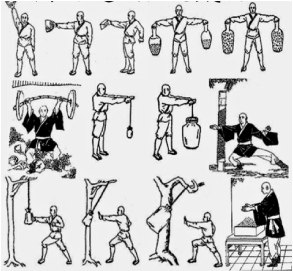
Hojo undo (補助運動) is a Japanese term, translated as "supplementary or supported exercises" and is a type of physical exercise which uses resistance to oppose the force generated by muscles through concentric and eccentric contractions. The weighted items used in this training are also known as kigu undo (機具運動, "machinery movement")
Hojo undo training in the martial arts is a centuries old practice and an essential part of our martial arts training. Unfortunately, in the wake of the past 150+ years modernization of today’s martial arts, much of the context and intent of the original martial arts has been lost
To create a slightly deeper understanding, we need to action a bit of language comprehension bunkai by dissecting and analyzing each of the 4 kanji for Hojo Undo
補 - supplement, supply, make good, offset, compensate, assistant, learner
助 - help, rescue, assist
運 - carry, luck, destiny, fate, lot, transport, progress, advance
動 - move, motion, change, confusion, shift, shake
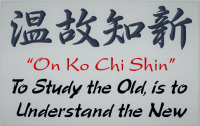
This simple lack of understanding of the true purpose of training has led to many traditional training aspects being tossed aside as they are considered outdated or obsolete. Fortunately for our dojo, we have a lifeline to the past very few are privileged to have. This exemplifies the Okinawan proverb, “To study the old, is to understand the new”
While most people associate strength training with lifting weights (barbells and dumbbells), it can also be done using other equipment (e.g.: bands, suspension ropes, gym machines, etc.) or using no equipment at all (e.g.: body weight exercises, such as push-ups and pull-ups)
Hojo undo training, specifically those created by Chojun Miyagi for GoJu-Ryu, were superficially designed to develop ambidextrous muscular strength, stamina, speed, improve technical performance, posturing and more; all designed to impact the quality of life of a person well into advanced age. The ancient masters understood the need to balance their training to train both the external shell and the internal life support systems
In the field of Sports Medicine, this type of training is known as “The Law of Specificity”, which states that to get better in any activity, you must precisely practice the skill that you wish to develop. This specific law overrules the other training principles: Overload, Reversibility, Progression, Individualization, Periodization. Like that of Junbi Undo, this training principle supports one of our key training concepts of “Form Follows Function”
One of the most overlooked areas in modern physical training practices are those related to the strengthening of the various sinews of the body and the myofascial network. Though not outwardly taught, this “internal” training can be found in “old world” Yoga, Chinese martial arts, and Qigong systems. This type of training is one of the greatest losses in today’s modern martial arts. In the case of our dojo, these and other guiding principles are the bedrock for our martial science-based training
There are over 900 sinews, ligaments, and cartilages in the human body
- Tendons are fibrous connective tissue serving for the attachment of muscles to bones and is capable of withstanding tension
- Ligaments are sheets or bands of tough fibrous tissue that connects to bones or cartilages at a joint or supporting an organ
- Cartilage is a stiff and yet flexible connective tissue that forms cushions and connects bones to bones. Cartilages help to keep the body connected
More important than training the various sinew of the body is the myofascial system. The myofascial system, which looks like a tight mesh spider suit that covers the entire body, is the multi-layered connective tissue in your body that holds, stabilizes, and connects everything. Without myofascia, you’d be a pile of bones, blood vessels, muscles, organs, and skin – lying in a heap on the floor
Fascia is a system of connective tissue that encases our body parts and binds them together. Fascia, made primarily of collagen, can be thought of as a sausage casing for your body's tissues. It surrounds muscles, nerves, tendons, and ligaments and gives them shape. Fascia also connects your skin to the tissue that is directly beneath it
There are 3 types of myofascial tissue
- The Superficial Fascia lies underneath the skin and the dermis. It connects the skin to the rest of the body – the bones, muscles, and organs. It’s also sometimes referred to as the subcutaneous layer or hypodermis. It’s the layer that’s most impacted in laceration and stab wound scenarios. As well as attaching skin to muscle and maintaining a constant body temperature, this fatty layer of yellowish myofascia is a vital part of the neck and cervical spine anatomy. It separates the delicate structures, like veins, lymph nodes, and the platysma muscle – into protected compartments
- When we go deeper, there’s the fibrous Deep Fascia. This dense and strong fascial layer supports and protects the muscles, holds our bones in place, and envelops the tendons, ligaments, and delicate network of blood vessels that run throughout the body. It’s your body’s equivalent of the National Guard – protecting it from injury and bacteria entering via the skin and the mucous membranes to prevent infection from spreading and invading the muscles. It is full of nerves and pain sensors, too, so if you tear a tendon or strain a ligament, your deep fascia will tell you about it – loud and clear – by sending pain signals back to your brain
- Diving deeper still, we find the Visceral Fascia surrounding our internal organs. This layer keeps our hearts beating, lungs inflating and deflating, and our digestive systems moving waste and toxins out of our body
When you injure a body part, healthcare professionals tend to focus solely on that part; an injury to your Achilles tendon usually results in your physician or physical therapist focusing on the tendon. Some of that focus should be on the fascia, as it is woven into all our body's systems, holding them together, giving them shape, and allowing pain-free functional movement to occur
Putting the above into our varied trainings further supports our #1 Rule of Karate: Protect Yourself
While there are endless examples of hojo undo training implements, the following table provides just a few examples and are just a few feet away from where I am typing this paper in my living room
Hojo Undo Training Implements
Images of Hojo Undo equipment and students training with Hojo Undo at Sensei Chojun Miyagi’s outdoor “Garden Dojo” (Post WWII)
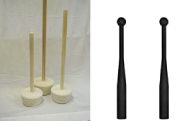
Chi ishi (鎚石), meaning "stone mallet" or "weighted levers", are concrete weights attached to a wooden pole. The practitioner grips the end of the wooden pole opposite the concrete weight and moves the wrist and arms in motions used in techniques normally used in kata or against opponents. This weighted training mostly helps to strengthen the fingers, hands, arms, shoulder, and chest
Weighted bats/batons are modern versions of the chi ishi.
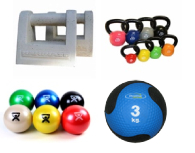
Ishi Sashi[ (石錠), "stone padlock", are hand-held weights in the shape of padlocks, traditionally made of stone. They are also known as Shísuǒ (石锁) in Chinese
Modern version of the ishi sashi are kettle bells and various types of weighted balls.
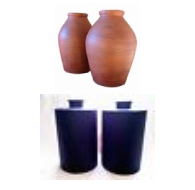
Nigire Game – Traditionally, Nigiri game (握り甕, "gripping jars") are ceramic jars and can be filled with sand to different weights. The jars are gripped around a lipped rim. Exercises can be performed from a stationary position or moving through various stances while holding the jar to strengthen the grip, arms, shoulders, core (koshi/gamaku), and legs
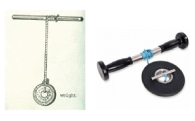
Makiage Kigu - The makiage kigu (巻下器, "wrist roller") is a weight hanging by a cord attached to from a wooden handle. The practitioner grasps the handle with the weight hanging in the middle and twists the handle to wrap the rope around the handle. The handle is raised and lowered throughout the twisting to strengthen the wrists
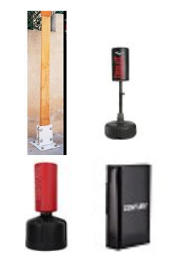
Makiwara – Traditionally, the makiwara (巻藁, literally "wound straw") is a striking board wrapped with straw and used to practice striking a target that provides resistance. There are two types of makiwara: age-makiwara (上げ巻藁- hung from the ceiling) and the more common tachi-makiwara (立巻藁- secured in the ground)
Modern versions of the makiwara are hanging bags, standup bags, handheld kicking and punching pads/mitts
‹ Back
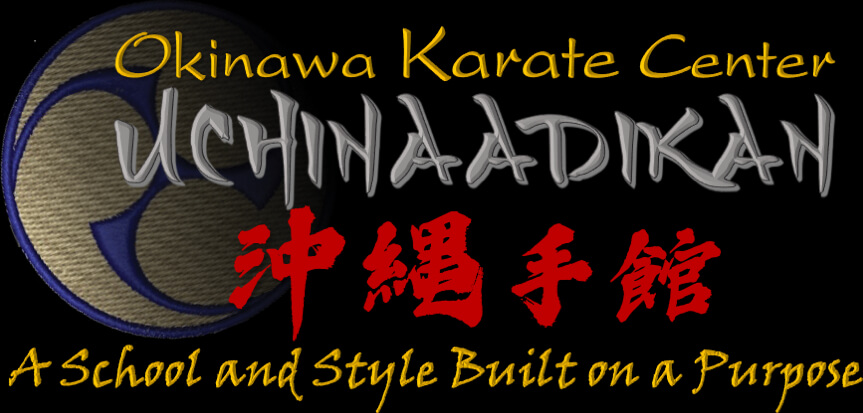



 ·
· 